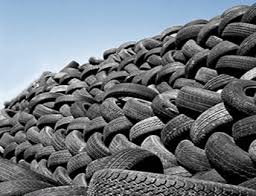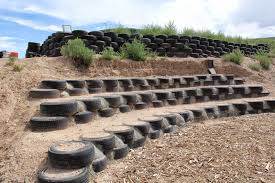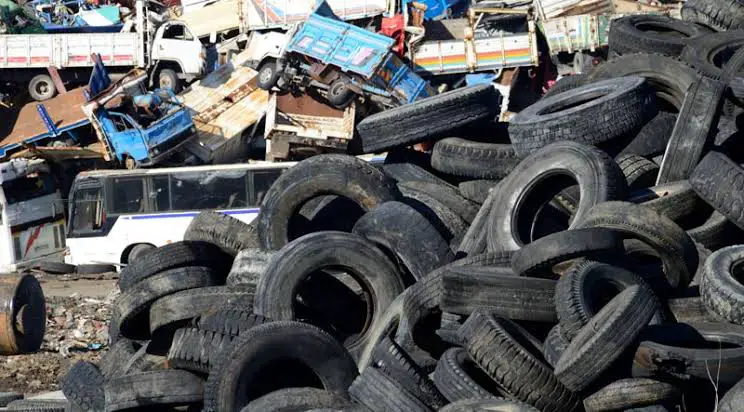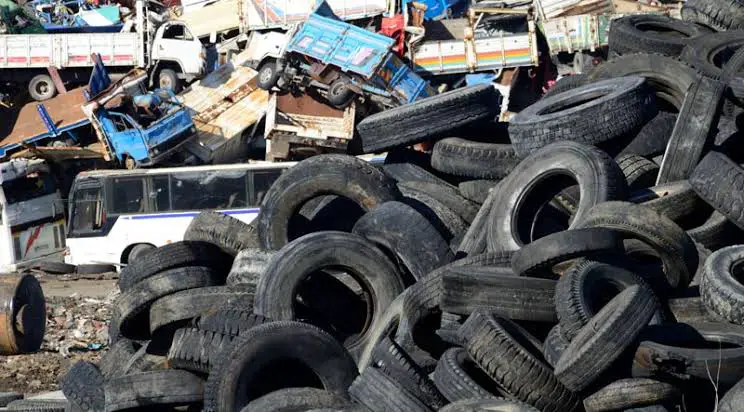Practical Steps to Convert Tires Wastes into Rags; Tires wastes can be turned into rags, this is a good way to recycle old tires. When tires are not needed anymore, they can be reused in different ways. One way is to turn them into rags. This helps to reduce waste and makes something useful out of something that would otherwise be thrown away.
The process of turning tires into rags is not complicated. First, the tires are collected from places where they are no longer needed. These could be old tires from cars, trucks, or bicycles. Then, they are cleaned to remove any dirt or debris. This is important to make sure that the rags made from the tires are clean and safe to use.
After cleaning, the tires are cut into smaller pieces. These pieces are then processed to remove any metal or other materials that may be inside the tires. Once the tires are clean and free of any contaminants, they are shredded into small fibers. These fibers can then be woven together to make rags.
The rags made from tires can be used for many purposes. They can be used for cleaning, wiping, or even as padding for various applications. Because tires are made from durable materials, the rags made from them are strong and long-lasting. This makes them ideal for tasks that require tough and reliable materials.
Using tires wastes to make rags is also good for the environment. Instead of adding to landfills, old tires are being repurposed into something useful. This helps to reduce the amount of waste that ends up in landfills and helps to conserve natural resources. Additionally, recycling tires into rags helps to reduce the need for new materials, which can help to lower overall energy consumption and greenhouse gas emissions.
Converting tires wastes into rags is a simple and effective way to recycle old tires. It helps to reduce waste, conserve resources, and create useful products out of materials that would otherwise be discarded. By using rags made from tires, we can help to protect the environment and make use of materials in a sustainable way.
Read Also: Practical Steps to Convert Tires Wastes into Construction Materials
Types of Recyclable Tires Wastes and their Uses

There are various types of recyclable tires wastes, each with its own unique characteristics and potential uses. Here are some common types of recyclable tires wastes and how they can be repurposed:
1. Whole Tires: Whole tires can be reused in several ways. They can be used as barriers for erosion control along highways or in playgrounds as safety surfaces. Some creative uses include making tire swings or using them as planters for gardens.
2. Tire Chips: Tires can be shredded into small chips or crumbs. These tire chips are often used as a landscaping material for pathways, playgrounds, and athletic tracks. They can also be used as a base for roads or as a component in construction materials like concrete.
3. Rubber Mulch: Another common use for shredded tires is as rubber mulch in landscaping. Rubber mulch is a durable and long-lasting alternative to traditional wood mulch. It helps to retain moisture, suppress weeds, and insulate soil, making it ideal for gardens, playgrounds, and flower beds.
4. Crumb Rubber: Crumb rubber is finely ground rubber made from recycled tires. It can be used in various applications, including as a filler in synthetic turf fields, as an additive in asphalt for road construction, or as a cushioning material in sports surfaces like running tracks and athletic fields.
5. Tire-Derived Aggregate (TDA): TDA is a lightweight aggregate made from shredded tires. It can be used in civil engineering applications such as backfill for retaining walls, lightweight fill for embankments, or as a drainage material in septic systems and landfills.
6. Tire-Derived Fuel (TDF): TDF is a fuel derived from shredded tires that can be used as a supplement to traditional fuels like coal in industrial processes such as cement kilns or power plants. It provides a reliable and cost-effective alternative fuel source while reducing the environmental impact of tire disposal.
7. Recycled Rubber Products: Tires can also be recycled into a wide range of rubber products, including mats, flooring tiles, playground surfaces, and automotive parts. These recycled rubber products offer the same durability and performance as traditional rubber materials but with the added benefit of being environmentally friendly.
Overall, the recyclable tires wastes mentioned above offer a sustainable solution to managing used tires while also providing valuable materials for various applications. By repurposing tires into new products, we can reduce waste, conserve resources, and create a more environmentally friendly society.
How to Convert Tires Wastes into Rags

Converting tires wastes into rags is a practical way to recycle old tires and give them a new purpose. Here’s a simple overview of how this process can be done:
1. Collection: Start by collecting old tires from various sources, such as automotive repair shops, tire retailers, or recycling centers. Ensure that the tires are no longer usable for their original purpose and are free from hazardous materials.
2. Cleaning: Clean the tires thoroughly to remove any dirt, debris, or contaminants. This step is essential to ensure that the rags produced from the tires are clean and safe to use. Use water, soap, and scrub brushes to clean both the inside and outside surfaces of the tires.
3. Cutting: Once the tires are clean, cut them into manageable pieces using a sharp knife or a specialized tire cutting machine. Cut the tires into strips or sections, depending on the desired size and thickness of the rags.
4. Shredding: After cutting, shred the tire pieces into smaller fibers using a shredding machine or equipment. This process breaks down the tires into fine strands, which will later be woven together to create the rags.
5. Separation: Remove any metal or other non-rubber materials from the shredded tire fibers. This can be done manually by handpicking or using a magnetic separator to extract metal components from the rubber fibers.
6. Weaving: Once the tire fibers are clean and free from contaminants, they can be woven together to make rags. This can be done using traditional weaving techniques or modern machinery, depending on the scale and requirements of the operation.
7. Finishing: After weaving, the rags may undergo additional finishing processes, such as trimming excess fibers, hemming edges, or applying reinforcing stitches. This helps to ensure that the rags are of high quality and durable enough for their intended use.
8. Quality Control: Finally, inspect the finished rags for any defects or irregularities. Ensure that they meet the desired specifications in terms of size, thickness, and overall quality before packaging and distribution.
By following these steps, tires wastes can be effectively converted into rags, providing a sustainable solution for recycling old tires and reducing waste.
The Benefits of Converting Tires Wastes into Rags
Recycled rags offer a variety of uses and benefits, making them a valuable resource in various industries and applications. Here are some of the key uses and benefits of recycled rags:
Uses:
1. Cleaning and Wiping: Recycled rags are commonly used for cleaning surfaces, wiping spills, and dusting furniture. Their absorbent and reusable nature makes them ideal for everyday cleaning tasks in households, businesses, and industrial settings.
2. Industrial Applications: In industrial settings, recycled rags are used for wiping machinery, cleaning equipment, and applying lubricants or solvents. They are essential for maintaining cleanliness and ensuring the smooth operation of machinery and production processes.
3. Painting and Staining: Recycled rags are often used for painting, staining, and applying finishes in construction, automotive, and woodworking industries. Their ability to absorb and spread liquids evenly makes them suitable for various painting and finishing tasks.
4. Janitorial Services: Janitorial services and cleaning companies use recycled rags for a wide range of cleaning tasks, including mopping floors, sanitizing surfaces, and polishing fixtures. Recycled rags are cost-effective and efficient for maintaining cleanliness in commercial and public spaces.
5. Automotive Maintenance: Recycled rags are indispensable for automotive maintenance tasks such as cleaning interiors, wiping down exteriors, and applying wax or polish. They help to keep vehicles clean and presentable while reducing the environmental impact of disposable cleaning products.
6. Crafts and DIY Projects: Recycled rags can be used for various crafts and DIY projects, such as quilting, sewing, and upholstery. They can be cut, sewn, and repurposed into new creations, adding a sustainable and eco-friendly element to creative endeavors.
Benefits:
1. Environmental Sustainability: Using recycled rags helps to divert waste from landfills and reduces the demand for virgin materials. By repurposing materials that would otherwise be discarded, recycled rags contribute to environmental sustainability and resource conservation.
2. Cost Savings: Recycled rags are often more affordable than new disposable cleaning products, saving money for businesses, households, and organizations. Reusing materials reduces the need for purchasing new supplies, resulting in cost savings over time.
3. Durability and Reusability: Recycled rags are typically durable and long-lasting, allowing them to withstand multiple uses and washings. Their reusable nature makes them a sustainable alternative to single-use cleaning products, reducing waste and minimizing environmental impact.
4. Versatility: Recycled rags can be used for a wide range of cleaning, maintenance, and DIY tasks, making them a versatile and multifunctional resource. From household chores to industrial applications, recycled rags offer practical solutions for various needs and requirements.
5. Reduced Carbon Footprint: Using recycled rags instead of disposable cleaning products helps to lower carbon emissions associated with manufacturing, transportation, and disposal. By choosing recycled rags, individuals and businesses can contribute to reducing their carbon footprint and mitigating climate change.
Overall, the uses and benefits of recycled rags make them a valuable and sustainable resource for cleaning, maintenance, and creative endeavors. By incorporating recycled rags into daily routines and practices, individuals and organizations can support environmental conservation efforts and promote a more sustainable future.
Read Also: Practical Steps to Convert Textiles (Clothing) into Asphalt
The Challenges of Converting Tires Wastes into Rags and their Solutions

Converting tires wastes into rags presents several challenges, but with innovative solutions, these challenges can be addressed effectively. Here are some of the main challenges and their corresponding solutions:
Challenges:
1. Collection and Sorting: Collecting and sorting tires wastes can be challenging due to the diverse sources and types of tires. It requires coordination with tire retailers, automotive shops, and recycling centers to ensure a steady supply of tires for recycling.
2. Cleaning and Preparation: Cleaning and preparing tires wastes for processing into rags can be labor-intensive and time-consuming. Removing dirt, debris, and contaminants from the tires requires specialized equipment and techniques to ensure the quality and safety of the resulting rags.
3. Processing and Shredding: Processing tires wastes into fine fibers for weaving into rags requires heavy-duty shredding equipment and machinery. Maintaining and operating these machines can be costly and may require skilled personnel to ensure efficient and effective processing.
4. Contamination and Quality Control: Contamination of tire fibers with metal or other non-rubber materials can affect the quality and performance of the resulting rags. Ensuring proper separation and quality control measures are in place is essential to prevent contamination and maintain the integrity of the recycled rags.
5. Market Demand and Competition: Finding markets and buyers for recycled rags can be challenging, especially with competition from other cleaning products and materials. Creating awareness about the benefits of recycled rags and building partnerships with potential buyers can help generate demand and secure sales channels.
Solutions:
1. Establishment of Collection Networks: Collaborate with local governments, businesses, and organizations to establish collection networks for tires wastes. Implement initiatives such as tire buyback programs or incentivize tire recycling to encourage participation and increase the supply of tires for recycling.
2. Investment in Cleaning Technology: Invest in advanced cleaning technology and equipment to streamline the cleaning and preparation process for tires wastes. Implement automated cleaning systems and quality control measures to improve efficiency and ensure the cleanliness of the recycled rags.
3. Optimization of Shredding Processes: Optimize shredding processes and equipment to increase throughput and reduce processing costs. Implement regular maintenance and upgrades to shredding machinery to improve reliability and performance.
4. Enhanced Quality Control Measures: Implement rigorous quality control measures throughout the recycling process to detect and remove contaminants from tire fibers. Utilize advanced sorting and separation technologies to ensure the purity and integrity of the recycled rags.
5. Market Development and Promotion: Develop targeted marketing strategies to promote the benefits of recycled rags and educate consumers about their uses and applications. Collaborate with retailers, distributors, and end-users to create demand and expand market opportunities for recycled rags.
Frequently Asked Questions (FAQs) About How to Convert Tires Wastes into Rags
1. Q: What types of tires can be used to make rags?
A: Various types of tires can be used, including those from cars, trucks, bicycles, and even heavy machinery. As long as the tires are no longer usable for their original purpose and are clean and free from contaminants, they can be recycled into rags.
2. Q: How are tires wastes collected for recycling into rags?
A: Tires wastes are collected from various sources, such as automotive repair shops, tire retailers, recycling centers, and even individuals. Some communities have tire recycling programs in place, while others may require individuals or businesses to take tires to designated drop-off locations.
3. Q: What is the process for converting tires wastes into rags?
A: The process typically involves cleaning the tires to remove dirt and debris, cutting them into smaller pieces, shredding the pieces into fibers, and then weaving or stitching the fibers together to make rags. The exact process may vary depending on the equipment and techniques used by the recycling facility.
4. Q: Are there any environmental benefits to recycling tires into rags?
A: Yes, recycling tires into rags offers several environmental benefits. It helps to reduce the amount of waste going to landfills, conserves natural resources by reusing materials, and reduces the need for new raw materials. Additionally, recycling tires helps to prevent pollution and conserve energy compared to producing new materials from scratch.
5. Q: What are some common uses for rags made from recycled tires?
A: Recycled tire rags can be used for various cleaning, wiping, and maintenance tasks. They are commonly used in households, businesses, and industrial settings for tasks such as cleaning surfaces, wiping spills, and maintaining machinery. Additionally, recycled tire rags are used in automotive maintenance, painting, staining, and crafting projects.
6. Q: Are there any safety concerns associated with using rags made from recycled tires?
A: Generally, rags made from recycled tires are safe to use, especially if they have been properly cleaned and processed. However, it’s essential to ensure that the rags are free from contaminants and do not pose any health risks. As with any cleaning product, it’s advisable to follow proper handling and disposal guidelines to minimize any potential risks.
Read Also: Abyssinian Cat (Felis catus) Description and Complete Care Guide

